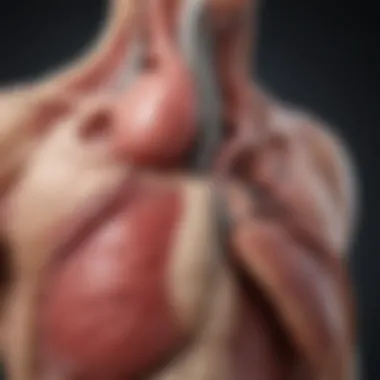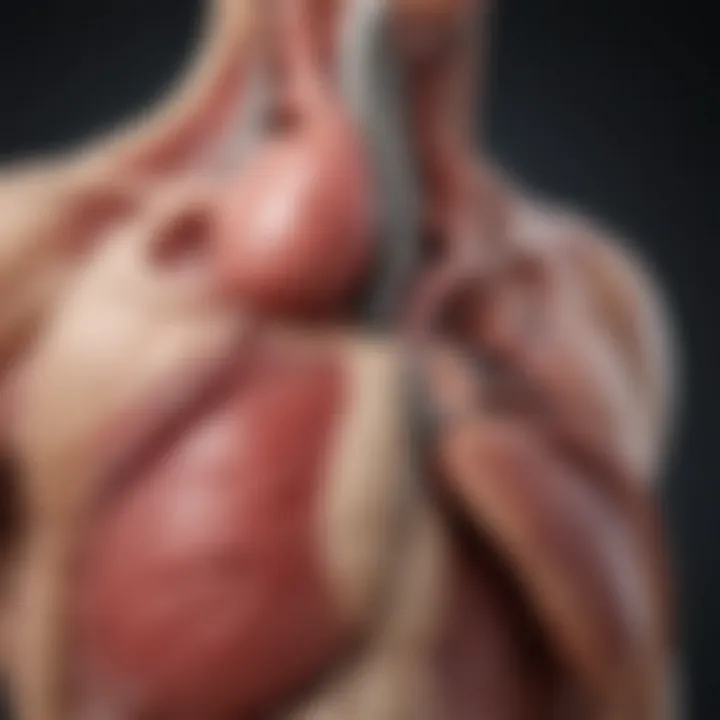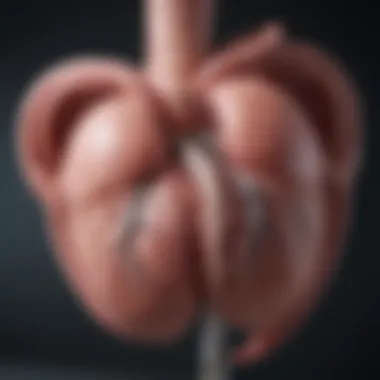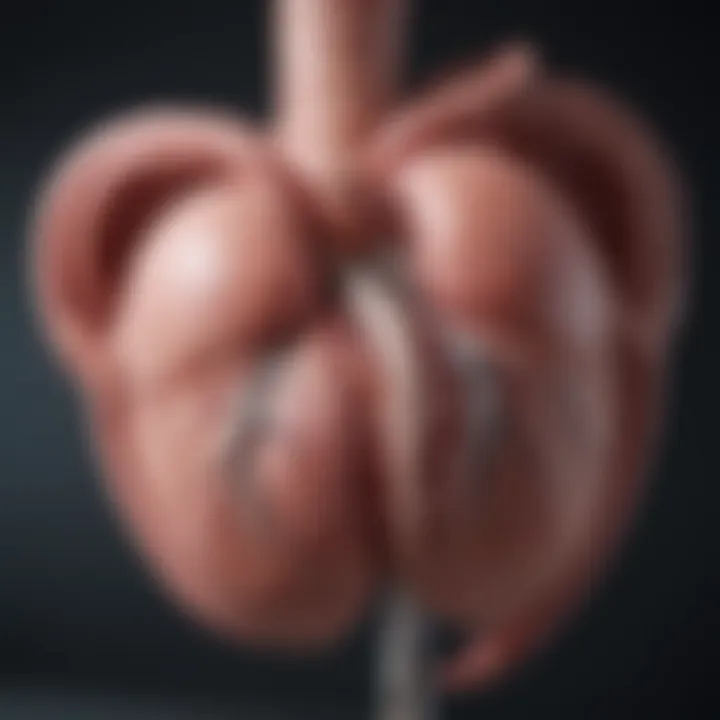Understanding Stanford Type B Aortic Dissection


Article Overview
Purpose of the Article
This article aims to provide an in-depth understanding of Stanford Type B aortic dissection, a condition that significantly impacts cardiovascular health. By exploring the pathophysiology, clinical manifestations, and management strategies, it serves as a comprehensive guide for students, researchers, educators, and healthcare professionals. The intention is to illuminate critical aspects of diagnosis and treatment, emphasizing the importance of timely intervention and supportive care in improving patient outcomes.
Relevance to Multiple Disciplines
Stanford Type B aortic dissection is not solely a concern for cardiologists; it encompasses various fields such as radiology, surgery, and emergency medicine. Understanding the complexities of this condition requires collaboration among professionals from these disciplines. It is paramount for practitioners to recognize the diverse presentations and potential complications associated with aortic dissections, as well as the advances in imaging that aid in their diagnosis. This comprehensive overview offers insights that can be valuable across these fields, ultimately promoting a multidisciplinary approach to patient care.
Research Background
Historical Context
The study of aortic dissection has evolved significantly over the years. Historically, the survival rate for patients experiencing aortic dissection was low, often due to delayed diagnosis and inadequate treatment options. Advances in medical imaging and surgical techniques have markedly improved outcomes. Understanding this historical backdrop provides context for current diagnostic and management strategies.
Key Concepts and Definitions
To effectively discuss Stanford Type B aortic dissection, it is crucial to establish key definitions. Aortic dissection refers to a tear in the inner layer of the aorta, causing blood to flow between the layers, leading to a separation of the vessel wall. Stanford Type B specifically involves dissections that occur distal to the left subclavian artery. Recognizing these definitions aids in understanding the implications of the condition and the approaches to treatment.
Preface to Aortic Dissection
Aortic dissection is a critical condition that warrants close examination due to its serious implications for cardiovascular health. Understanding aortic dissection is vital for healthcare professionals and researchers alike, as it influences both patient outcomes and treatment strategies. The dissection involves a tear in the aorta’s inner layer, which can lead to catastrophic consequences such as aortic rupture or organ ischemia. Therefore, timely identification and management are crucial.
In the context of this article, focusing on aortic dissection, especially Stanford Type B, provides a framework for dissecting the complexities surrounding this medical emergency. The classification of aortic dissections helps clinicians swiftly assess the severity and urgency of the condition, ultimately guiding therapeutic choices. This classification delineates Type A and Type B dissections, each with distinct anatomical and clinical considerations, which is critical for effective patient management.
Definition and Classification of Aortic Dissections
Aortic dissection is classified mainly based on the involvement of the ascending aorta, which distinguishes between Stanford Type A and Type B dissections. Type A involves the ascending portion, while Type B involves only the descending aorta. The classification provides clarity in treatment approaches since Type A typically requires surgical intervention, whereas Type B may often be managed conservatively. This classification is essential for fostering a standardized understanding among clinicians, researchers, and students, ensuring coherent communication and strategic management plans.
The definitions and classifications surrounding aortic dissection extend beyond simple terminologies. They significantly impact clinical practice, dictating urgency in patient care and influencing outcomes. As such, an accurate understanding of these classifications is indispensable for all involved in cardiovascular care.
Historical Context
The concept of aortic dissection is not new; historical records trace back its identification. However, the medical community's understanding has evolved considerably since the early descriptions. Initially, aortic dissection was often misclassified, leading to inadequate management strategies and poor patient outcomes. Early cases illustrated a lack of awareness regarding the differentiation between aortic dissection types and their implications.
With advancements in medical imaging and surgical techniques, knowledge has expanded. Key historical milestones include the development of non-invasive imaging techniques that have made diagnosing aortic dissections more accurate and timely. The historical context allows modern practitioners to appreciate the strides made in the recognition and management of aortic dissections, informing future practices and highlighting ongoing areas for research. Understanding this evolution helps frame the significance of current studies and the need for continuous advancements in the understanding of this complex condition.
Understanding Stanford Classification
The Stanford Classification system for aortic dissections serves as a vital framework for understanding and managing this complex cardiovascular condition. It categorizes aortic dissections into two primary types: Type A and Type B, each with distinct anatomical involvements, clinical implications, and management strategies. This classification is based on the location of the dissection relative to the left subclavian artery, which is crucial when considering the patient's treatment options and prognosis.
This classification simplifies the clinical approach by providing a clear distinction that aids healthcare providers in making critical decisions quickly. With a notable emphasis on the significance of identifying Type B, this section elaborates on that classification's functionality in clinical settings. The implications of misdiagnosis can be severe, making a robust understanding of the classification imperative for health professionals.
Overview of Stanford Type A and B Aortic Dissections
Stanford Type A dissection involves the ascending aorta and can extend to the aortic arch and beyond. It is known for presenting a greater risk of complications, including acute aortic rupture and cardiac tamponade. Patients with Type A often exhibit severe symptoms, such as abrupt chest pain, which necessitates rapid intervention.
In contrast, Stanford Type B dissection primarily involves the descending aorta, beginning beyond the left subclavian artery. Although it is typically associated with a better prognosis than Type A, it still poses significant risks. Symptoms may include back pain and abdominal discomfort, which can lead to delays in diagnosis if not properly evaluated. The primary treatment approach for Type B may be non-surgical, emphasizing blood pressure control and monitoring, yet complications can still arise requiring surgical intervention.
Clinical Importance of the Classification
The classification of aortic dissections into Type A and B holds immense clinical relevance. Understanding this classification informs the urgency of care needed for patients experiencing these conditions. Type A dissections generally require surgical repair, while Type B can often be managed conservatively. However, recognizing when a Type B dissection evolves into a complicated scenario is equally important.
Studies have shown that early diagnosis significantly impacts patient outcomes. By categorizing dissections, practitioners can prioritize diagnostic imaging and interventions more efficiently.
- Key points regarding the classification:


- Type A: Ascending aorta involvement, requiring urgent surgical intervention.
- Type B: Descending aorta, generally managed with conservative measures unless complications arise.
- Early identification can improve survival rates and reduce complications.
This classification not only impacts treatment pathways but also facilitates research into outcomes associated with different types of dissections. Understanding the clinical importance enhances collaboration among practitioners leading to improved care standards and methodologies.
Pathophysiology of Stanford Type B Aortic Dissection
The pathophysiology of Stanford Type B aortic dissection represents a complex interplay of anatomical and biochemical factors. Understanding these mechanisms is essential for clinicians and researchers alike. The dissection typically initiates in the descending aorta and can lead to various complications. It is crucial to address why some individuals suffer this condition while others do not.
Anatomical Considerations
Anatomy plays a pivotal role in aortic dissections. The aorta, being the largest artery, conducts blood from the heart to the rest of the body. It comprises three layers: the intima, media, and adventitia. In Type B dissections, the rupture occurs between the intima and the media, creating a false lumen. This format deprives the body of proper blood flow and can lead to organ ischemia. The descending aorta is particularly vulnerable because of its position and the stress placed on it by blood flow.
Furthermore, the branching pattern of the arteries off the aorta is noteworthy. When dissection occurs, it may compromise the blood supply to vital organs. Careful examination of a patient’s anatomy can provide insight into the dissection’s potential impact and guide management strategies.
Triggering Factors for Dissection
Several factors may trigger an aortic dissection. The most common include:
- Hypertension: Chronic high blood pressure can weaken the aortic wall.
- Trauma: Physical injuries, such as those from car accidents, can initiate dissection.
- Rapid changes in blood pressure: Sudden fluctuations can stress the aorta.
In addition, certain lifestyle choices also influence these risk factors. Smoking and obesity have well-established connections to hypertension and vascular health.
Statistical data show that among patients with Type B dissection, a significant proportion has a history of hypertension. Recognizing these factors can facilitate early intervention.
Role of Connective Tissue Disorders
Connective tissue disorders represent a substantial risk for aortic dissection. Conditions such as Marfan syndrome, Ehlers-Danlos syndrome, and other genetic disorders compromise the structural integrity of the aorta. These disorders lead to alterations in collagen and elastic fibers, making the aorta susceptible to damage.
“Patients with genetic predispositions warrant careful monitoring, as they have an elevated risk for aortic dissections.”
“Patients with genetic predispositions warrant careful monitoring, as they have an elevated risk for aortic dissections.”
Identification of these disorders is vital. Patients exhibiting features related to connective tissue disorders should undergo thorough cardiovascular evaluation. Early detection and management strategies can drastically reduce complications associated with aortic dissections.
In summary, the pathophysiology of Stanford Type B aortic dissection involves critical anatomical structures, potential triggering factors, and the influence of connective tissue disorders. Insight into these aspects may enhance the understanding of dissection mechanics and guide clinical approaches.
Clinical Presentation
The clinical presentation of Stanford Type B aortic dissection is a crucial element of understanding this serious condition. The manner in which the dissection manifests can heavily influence both the diagnosis and the subsequent management strategies. Clear identification of symptoms can facilitate timely intervention, potentially improving patient outcomes. Thereby, healthcare professionals must be vigilant in recognizing the signs presented by patients. Key aspects include the nature of the symptoms, their onset, and how they progress.
Common Symptoms of Type B Dissection
Patients with Stanford Type B aortic dissection often present with a range of specific symptoms. These symptoms can vary in intensity and duration. Some of the most common include:
- Severe Chest Pain: Often described as sharp or tearing, this pain typically originates in the back or chest and may migrate as the dissection evolves.
- Back Pain: Many patients report significant pain in the interscapular region.
- Abdominal Pain: Pain may also radiate to the abdomen, complicating the diagnosis.
- Hypotension: A drop in blood pressure can occur, indicating a serious risk to the patient.
- Neurological Deficits: Some patients may experience weakness or confusion due to potential complications.
These indicators are not universally present, making it imperative for clinicians to engage in thorough patient assessments. Identifying these symptoms in their early stages can be critical for managing the condition effectively.
Differential Diagnosis
Differential diagnosis for Stanford Type B aortic dissection is a complicated process due to overlapping symptoms with other medical conditions. The clinician must consider a variety of differential diagnoses to rule out other possible causes of the presenting symptoms, including:
- Myocardial Infarction: Similar chest pain may lead to confusion in diagnosis.
- Pulmonary Embolus: Shortness of breath and chest pain could mimic dissection symptoms.
- Pneumothorax: An acute presentation with chest pain can arise from a collapsed lung.
- Esophageal Rupture: Severe pain may also indicate a rupture in the esophagus.
A thorough evaluation, including diagnostic imaging, plays a vital role in establishing the correct diagnosis. Healthcare practitioners rely on imaging techniques such as CT scans to differentiate between these conditions, ensuring that proper treatment is initiated at the right time.
Ultimately, a meticulous approach to clinical presentation not only aids in accurate diagnosis but also facilitates the formulation of specialized treatment protocols tailored to the needs of individual patients.


Diagnostic Imaging Techniques
Diagnostic imaging is a crucial component in the management of Stanford Type B aortic dissection. Accurate diagnosis is essential for effective treatment and can significantly influence patient outcomes. Various imaging techniques provide distinct advantages and have their own limitations, which make the choice of method important in clinical practice.
CT Angiography
CT angiography is considered a gold standard in diagnosing aortic dissection. It offers rapid and detailed visualization of the aorta and its branches. High-resolution images allow clinicians to assess the extent of the dissection, which is critical for planning treatment strategies.
Benefits of CT angiography include:
- Speed: It can be completed quickly, which is vital for patients in acute situations.
- Detail: Provides excellent anatomical details, enabling the identification of complications such as aortic rupture.
- Accessibility: Widely available in most medical facilities, making it a common choice for acute care.
However, factors such as contrast allergy, renal function impairment, and radiation exposure need to be considered. The potential for misinterpretation of images also exists, especially in less experienced hands.
MRI in Aortic Dissection Diagnosis
Magnetic Resonance Imaging (MRI) serves as an alternative to CT angiography, especially when long-term follow-up imaging is needed. It provides excellent soft tissue contrast and does not involve radiation, making it suitable for certain patient populations, such as pregnant women or younger patients requiring multiple scans.
Some noteworthy aspects of MRI include:
- Non-invasive: No radiation exposure is a significant benefit, especially for frequent imaging.
- Comprehensive: Can visualize adjacent structures and provide functional assessment of the heart and aorta.
Nonetheless, MRI is less accessible and time-consuming compared to CT. Patients with certain implants or claustrophobia may also face limitations in using this imaging method.
Traditional Imaging Methods
While CT and MRI have become predominant in diagnosing aortic dissection, traditional methods still hold some relevance. These include plain radiography and echocardiography. Plain radiographs can show indirect signs of aortic dissection such as abnormal aortic contour or mediastinal widening.
Echocardiography, particularly transesophageal echocardiography (TEE), is valuable in specific clinical settings, such as intraoperative monitoring or when patients cannot undergo CT or MRI. This method offers bedside assessment and can evaluate the heart’s function alongside the aorta.
Some key points about traditional methods are:
- Accessibility: Often more readily available, especially in emergency settings.
- Speed: Quick assessments can be made at the bedside in critical situations.
Management of Stanford Type B Aortic Dissection
The management of Stanford Type B aortic dissection is crucial due to its implications on patient outcomes and the complexities involved in treatment decisions. Understanding these management strategies helps healthcare professionals tailor interventions that match the individual patient's needs, preserving life and minimizing complications. In this section, we will explore conservative treatment approaches and the circumstances that necessitate surgical intervention. Both paths require careful consideration of risks and benefits, as well as a thorough understanding of the patient's specific clinical scenario.
Conservative Treatment Approaches
Conservative management is often the initial strategy for Stanford Type B aortic dissection, especially in stable patients. This approach emphasizes medical management aimed at controlling blood pressure and reducing stress on the aortic wall. Key elements of conservative treatment include:
- Blood Pressure Control: Medications such as beta-blockers and ACE inhibitors are essential. These help maintain lower systolic blood pressure levels and reduce the risk of further dissection.
- Pain Management: Effective control of pain is necessary. This improves the quality of life and may help stabilize the patient's condition.
- Continuous Monitoring: Patients require close surveillance. Regular imaging, such as CT scans, is often necessary to assess the dissection’s progression.
- Lifestyle Modifications: Avoidance of heavy physical activities can prevent complications. Patients are encouraged to follow a heart-healthy diet and quit smoking.
Conservative management benefits patients by minimizing the risks associated with surgical interventions. Many patients can maintain good quality of life and long-term control of the condition; however, the specifics of each case can change treatment goals significantly.
Surgical Interventions
Surgical intervention becomes critical in certain scenarios, particularly when conservative management fails or complications arise. Decisions for surgery hinge on several considerations, including the size and location of the dissection, patient symptoms, and overall health.
The two primary surgical options for Stanford Type B aortic dissection are:
- Endovascular Repair: This minimally invasive approach uses stent-grafts to reinforce the aorta. It allows for swift recovery and can be performed with reduced risk when compared to traditional methods.
- Surgical Resection: In cases of complications like rupture or malperfusion syndrome, more traditional open surgical approaches may be required. This offers direct access to the aorta for repairs or replacement but carries more significant postoperative risks.
The choice between these strategies involves assessing not just the immediate life-saving potential but also the possible long-term outcomes. For some patients, timely surgical intervention may offer the best chance at improved survival rates.
"The management of Stanford Type B aortic dissection requires a careful balancing act, weighing the risks of surgery against the benefits of conservative approaches. Each patient presents a unique case that warrants individual attention."


"The management of Stanford Type B aortic dissection requires a careful balancing act, weighing the risks of surgery against the benefits of conservative approaches. Each patient presents a unique case that warrants individual attention."
Ultimately, understanding the nuances of both conservative and surgical management equips healthcare professionals with the tools necessary to improve patient outcomes in the face of this serious condition.
Long-Term Outcomes and Prognosis
Understanding the long-term outcomes and prognosis of Stanford Type B aortic dissection is essential for both patients and healthcare providers. This section sheds light on crucial elements that influence survival rates and potential complications. A thorough comprehension of these factors can guide clinical decision-making, treatment strategies, and patient counseling.
Survival Rates and Factors Influencing Prognosis
Survival rates for patients with Stanford Type B aortic dissection have improved over the years, but they still vary significantly based on several factors. A study indicates that the overall mortality rate within the first month after a dissection occurs is approximately 10-20%. However, long-term survival can be better with timely diagnosis and appropriate treatment interventions.
Key factors impacting survival include:
- Age: Older patients generally have poorer outcomes.
- Comorbidities: Conditions like hypertension, diabetes, or coronary artery disease can complicate recovery.
- Initial presentation: The extent of dissection and presence of complications at diagnosis significantly affect prognosis.
- Management strategies: The choice of management, whether conservative or surgical, influences long-term survival rates.
Research suggests that early diagnosis followed by effective blood pressure control is crucial. Patients managed conservatively may have favorable outcomes if they are closely monitored and show no signs of complications.
Understanding Complications
Complications of Stanford Type B aortic dissection can be severe and impact long-term prognosis. Recognizing these complications is vital for preventing morbidity and mortality. Key complications include:
- Rupture: A life-threatening event whereby the dissection extends and breaches the arterial wall.
- Ischemia: Reduced blood flow to organs can lead to serious conditions like stroke or renal failure.
- Re-dissection: This can occur in the same or adjacent aortic segments, requiring further intervention.
- Chronic pain: Many patients experience persistent pain issues that affect quality of life.
Ongoing research aims to better understand these complications and develop strategies to mitigate them. Regular follow-up imaging and clinical evaluations are essential for early detection of issues and to ensure optimal management.
"Timely recognition of complications can be the difference between survival and adverse outcomes in patients with Stanford Type B dissection."
"Timely recognition of complications can be the difference between survival and adverse outcomes in patients with Stanford Type B dissection."
Current Research in Aortic Dissection
Exploration into the nuances of Stanford Type B aortic dissection is vital as it shapes the future of medical interventions and patient outcomes. Ongoing investigations delve into various dimensions, focusing on improving treatments, identifying risk factors, and understanding the biological implications of the disease. Research helps bridge gaps between existing knowledge and innovative practices, ensuring that medical professionals remain informed about the latest developments in patient care.
Innovations in Treatment
Recent studies have spurred significant innovations in treating Stanford Type B aortic dissection. Medical practitioners are increasingly employing minimally invasive techniques alongside traditional surgical methods. These techniques minimize recovery time and reduce the overall impact on patient health.
Some highlighted innovations include:
- Endovascular stent grafts: These devices have transformed the treatment landscape, allowing surgeons to repair aorta tears with precision.
- Increased use of imaging: Enhanced imaging techniques, like advanced CT scans and MRIs, allow for improved monitoring during and after treatment, which aids in customizing patient care plans.
- Personalized medication regimens: Continuous studies assess the effectiveness of various pharmaceuticals, leading to optimized treatments based on individual patient profiles.
This adaptive approach to treatment demonstrates promising outcomes with respect to recovery and long-term survival rates, which is invaluable for clinical practice.
Future Directions in Research
The future of aortic dissection research looks promising as efforts focus on several key areas. Exploring the genetic factors leading to aortic dissection can provide insights into prevention strategies that might aid at-risk populations. Researchers are also investigating the physiological changes that occur during aortic dissections, enriching the understanding of the condition.
Research directions include:
- Longitudinal studies assessing lifestyle impacts: There is much interest in how dietary and lifestyle choices affect dissection risk, serving as an opportunity for preventative measures.
- Exploration of novel biomarkers: Identifying new biomarkers may allow earlier detection of dissection events, improving patient management.
- The role of artificial intelligence: AI is being explored in predictive analytics for identifying patients at risk of dissection. This evolution can possibly lead to breakthroughs in interventions and patient care protocols.
As such, the trajectory of research into Stanford Type B aortic dissection stands as a testament to the continuous drive for advancements that can significantly alter diagnostic and therapeutic landscapes.
The End
In this article, we have examined the multifaceted nature of Stanford Type B aortic dissection. This condition poses significant challenges, not only due to its complex pathophysiology but also because of its variability in clinical presentations and outcomes. The conclusion highlights the critical elements outlined in our discussions, showcasing the significant aspects practitioners must consider.
Key Takeaways
- Stanford Type B aortic dissection primarily affects the descending aorta and requires timely recognition and management.
- Diagnostic imaging techniques, such as CT angiography and MRI, are vital in confirming the diagnosis and determining the extent of the dissection.
- Management strategies can vary widely, with conservative treatment being standard for stable patients, while surgical interventions may be necessary in acute cases to prevent complications.
- Long-term outcomes are influenced by factors such as the initial status of the patient, presence of co-morbidities, and the quality of ongoing medical care.
Final Thoughts on Management and Outcomes
As we synthesize the information presented throughout the article, it is essential to stress that understanding Stanford Type B aortic dissection requires a comprehensive approach. Ongoing research plays a critical role in enhancing our knowledge and management strategies. Emphasis on individual patient care and tailored treatment plans is necessary for improving survival rates and quality of life. Future directions in research may yield novel insights that further refine these management techniques.

